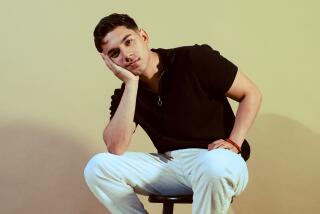Traditional trumps new
As traditional forms of music adapt to the social and technological changes of a new century, dance either stays nostalgic and backdated (classical ballet in America, for example) or struggles to keep up. That struggle informed the uneven but intriguing Fiesta Argentina 2007, a program of satisfying old and problematic new tango at the John Anson Ford Amphitheatre on Saturday.
In Act 1, the musical style remained contemporary but familiar as performed by the soulful veteran guitarist Pepe Rocha, the increasingly dramatic vocalist Guillermo Galvé and the accomplished, atmospheric Los Angeles Tango Quartet.
Composers were never credited in the house program, but by now such songs as “La Cumparsita” (by Gerardo Matos Rodríguez) and “Milongueando en el ‘40” (by Amando Pontier) have become as familiar as the images of iconic tango singer Carlos Gardel that were projected on a screen at the back of the stage.
The six-member Otero Dance Company appeared five times during this half of the program: twice as an ensemble but otherwise in showcases for single couples. Dancing in streetwear, Gloria Otero and James Eisman seemed to be playing a sly game, and though their approach stayed engagingly rough-edged and spontaneous, virtuosity continually informed their duet -- as when Otero froze on one foot and Eisman effortlessly rotated her at high speed.
Dazzlingly intricate in their partnership, Claudio Otero and Elizabeth Roccella danced as if they’d been together for decades, with no mysteries or secrets between them but plenty of shared experiences to recapitulate. As for Damian Romera and Vanina Mendez, they proved brilliantly unpredictable, their taut ballroom poses suddenly shattered when she whirled across his hips or sank to the floor or gave him a sweet kiss on the lips when he grew strangely impassive.
After intermission came a set by Tanghetto, a popular, skillful six-member Argentine group that experiments with what it calls “electrotango” but that added so much contemporary rock to its sound Saturday that it sometimes lost any sense of tango identity. Playing its own compositions along with pieces by New Order and Depeche Mode, the group also replaced the emblematic slide projections of Act 1 with energetic computer graphics: everything from views of home to a dancing roach, plus political graffiti (“No to the Bush agenda”).
Sometimes just the wheeze of the bandoneón reminded you that you were on tango turf, and that was clearly the point of the song “Alexanderplatz”: evoking the scraps of connection to the home culture that help sustain Argentines abroad. But it wasn’t enough for the Otero dancers, who seemed to find the lack of a deep rhythmic pulse in Tanghetto’s music troublesome.
Certainly everyone looked either arbitrary in movement choices or downright uncomfortable (especially Roccella and Claudio Otero), though Romera flipped Mendez with startling bravura during their duet and strove to look as imperturbable as ever. Working with Eisman, Gloria Otero dramatized the prevailing sense of missed connections by creating a little dance drama about their not belonging together.
But maybe this music doesn’t need or invite any dancing. That would be something new in the history of tango, something inevitable, perhaps, though it’s unlikely that even the young revolutionaries of Tanghetto look forward to the last dance in Buenos Aires with anything but regret.
More to Read
The biggest entertainment stories
Get our big stories about Hollywood, film, television, music, arts, culture and more right in your inbox as soon as they publish.
You may occasionally receive promotional content from the Los Angeles Times.










